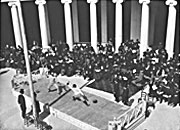Fencing
cctv.com 07-20-2004 11:05
Fencing is one of only four sports that have been featured in every modern Olympic Games, beginning in 1896.
Fencing calls for adaptability, inventiveness, good organization, and patience. This is achieved by good partnership between the fencer and the fencing master. Hard effort is needed if a competitor is to be ready for a match, and long hours must be spent in training, where great attention and discipline are needed.
Description
Fencing evolved from an ancient form of combat, and is practiced indoors. The fencer tries to score the total hits needed to win, while at the same time dexterously avoids being hit by the opponent.
Foil, ö¿pö¿e and sabre are the three weapons used in the sport of Fencing, in which both men and women compete. The target areas, as well as the blade, differ for the three weapons.
ATHENS 2004 Fencing
Some 200 fencers will be taking part in the 2004 Olympics. The Fencing competitions will be held in the Fencing Hall of the Helliniko Olympic Complex.
Six Fencing disciplines are on the Olympic programme, which include six individual and four team events:
1.Menãs foil (from 1896) ã individual & team events
2.Womenãs foil (from 1924) - individual events
3.Menãs epee (from 1896) ã individual & team events
4.Womenãs epee (from 1996) ã individual & team events
5.Menãs sabre (from 1896) ã individual & team events
6.Womenãs sabre (from 2004). ã individual events
History
From ancient works of art showing masked swordsmen, swords, and judges it would seem that swordplay goes back four thousand years. It was known to Egypt, China, India, and Greece. The Athenians regarded the people of Arcadia as the inventors of the art of fighting with weapons. Homer devotes two rhapsodies (chapters) of the Iliad to duels: one between Menelaus and Paris, and the other between Hector and Ajax.
According to extant references and written sources, sword fights appear in Egypt, and thousands of years later (in 2700-2200 BC) in China. The figures of swordsmen competing can be seen in representations dating back to.1200 BC. In Roman times, slaves and prisoners-of-war duelled for their lives and for their freedom in the arenas of Roman emperors.
Later on, in the Middle Ages, we find protective metal armour covering the entire body, which was essential because of the size and weight of the weapons and their sharp point. It was at this time that the first Fencing schools were founded, and the sport spread systematically throughout Europe.
The first rules of Fencing appeared in 1474, in Spain. The first handbook describing positions, lines and parries came out in 1530. In 1537, the Acadö¿mie dãArmes was founded in Paris. The foil made its debut in the 17th century: being a lighter weapon, it made exercise more pleasant. The mask became part of the fencerãs equipment in 1780, to protect the face, something that had previously been considered feminine and insulting.
|

|
|
|
By 1815, Fencing had developed to such an extent that there was detailed literature about it. The Italians, the Hungarians and the French were the first nations to create their own great Fencing schools, which show great differences when compared with one another. For a long time, they cultivated a style of Fencing that reflected their own models, and today all three are among the great world Fencing nations. Over time, Soviet and German fencers who had learnt much from the three prototype styles, exploited their physical attributes, their special characteristics and mentality to create their own national schools of Fencing.
Fencing is one of the nine sports that was featured on the programme of the first modern Olympic Games in 1896. From then on, they were constantly included in the competition programme of the Games. The International Fencing Federation (FIE) was founded on 29 November 1913. From 1920 to 1936, there were the ãChampionnats du Mondeã, a Fencing competition held from 1 to 15 August each year, with fencers from numerous countries taking part. This competition took place in the interim between Olympic events.
The first Fencing master in Greece was named Miller: he taught Fencing at the Evelpidon Military School, and published the first Greek Fencing manual. A pupil of his named Pyrgos published a book in 1872 entitled ãThe Art of Weaponry, Fencing and the Sabreã showing the influence of the French school. It was at about this time that a private Fencing school teaching the Italian style was founded, by Iliopoulos. The first Salle dãArmes in Greece was the Syllogos Philoplon Athenon [Athens Society of Lovers of Arms]. This merged with the Athenian Club and changed its name to ãAthenian Club To Xiphosã. The first Greek sporting body for fencing was thus created in 1888. The Greek Fencing Federation (EOX) was not founded until 1972, and up until then the sport of fencing was under the Greek Sports Association SEGAS.
Source:official website of the ATHENS 2004 Olympic and Paralympic Games
Editor:Wang Source: